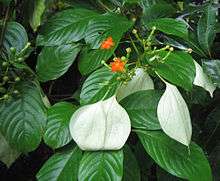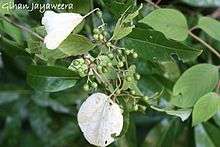Mussaenda frondosa
| Mussaenda frondosa | |
|---|---|
 | |
| Mussaenda frondosa | |
| Scientific classification | |
| Kingdom: | Plantae |
| Division: | Angiosperms |
| Order: | Gentianales |
| Family: | Rubiaceae |
| Genus: | Mussaenda |
| Species: | M. frondosa |
| Binomial name | |
| Mussaenda frondosa Linnaeus | |
| Synonyms[1] | |
| |
Mussaenda frondosa (Wild mussaenda or dhobi tree) is a plant of Rubiaceae family. It is a smaller shrub 1.5–2 m (4 ft 11 in–6 ft 7 in) tall by 1.5–2 m (4 ft 11 in–6 ft 7 in) wide. Like all other Mussaenda species, petals are visible as well as white leaves just below the flower. Usually they arose with fruits. Known as "Wal buthsarana (වල් බුත්සරන)" in Sinhala language.
Appearance
The flowers are clusters of orange-yellow tubular flowers beside large, white bracts, set among pale green, oval leaves; berries follow the bloom. The erect, branching stem has a shrubby crown.
Range
M. frondosaative to India, Nepal, Sri Lanka, Cambodia, Vietnam, Malaysia, and Indonesia.

Fruit
References
- ↑ "The Plant List: A Working List of All Plant Species". Retrieved 23 January 2015.
External links
- http://sphinxsai.com/s_v2_n2/PT_V.2No.2/phamtech_vol2no.2_pdf/PT=40%20(1236-1240).pdf
- http://thetropicalfloweringzone.com/2014/01/23/mussaenda-frondosa/
This article is issued from Wikipedia - version of the 6/24/2015. The text is available under the Creative Commons Attribution/Share Alike but additional terms may apply for the media files.